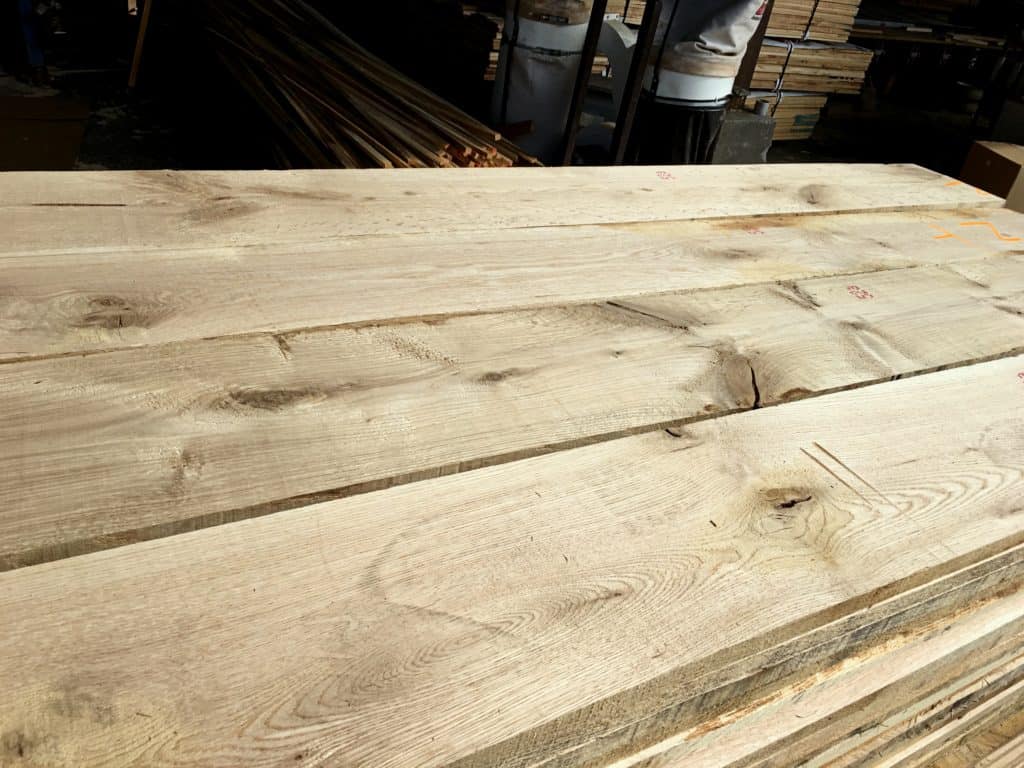
What is the Best French White Oak Alternative?
The best substitute for French Euro-cut Oak is slow-growth American White Oak that has been cut European style and graded for appearance. Here are the reasons:
- Grain pattern. The distinctive look of French Oak is partially due to its grain orientation. Sawing American Oak in the same manner yields a similar grain appearance.
- Oak growth rings. European White Oak is dense and grows slowly. Accordingly, its growth rings are tight. In the United States, only regions with long cold winters produce comparably tight growth rings.
- Heartwood. French Oak trees grow large. Additionally, their sap rings are thin and blend in closely with its heartwood. American White Oak generally has a larger exterior sap ring than its French counterpart. In addition, the sapwood color stands out from the heartwood. However, when US White Oak is graded for all heartwood, sap color is no longer an issue.
- Price. Premium quality US White Oak that has been sawn to European standards costs a fraction of imported French Oak.
Unfortunately, the majority of white oak produced in North America lacks the qualities to accurately mimic European White Oak. However, we have the formula to produce the correct grade of US White Oak.
One More Shocking Revelation.
The cost difference between US White Oak that looks nothing like French Oak and US White Oak that is almost indistinguishable is negligible.
What is French White Oak?
European White Oak, sometimes referred to as French White Oak, is a beautiful and expensive wood. Additionally, using French White Oak flooring adds an elegance to the appearance of a room.
Homeowners and designers understandably want to tap into the positive qualities of French White Oak but the cost often makes that option a non-starter. Over the course of my career I’ve seen companies try a few ill-advised workarounds:
Bad French Oak Substitutes
- The most egregious way to avoid the cost of true European White Oak is a straightforward misrepresentation of domestic white oak as French. Shady companies charge clients for expensive white oak while installing less expensive American White Oak. Distinguishing European from American can be difficult especially under a dark finish. As long as no one notices, a disreputable companies simply pocket the fraudulent material cost savings.
- A more common approach is using US white oak in the following configuration
- 1/3 plain-sawn
- 2/3 rift & quarter sawn, mixed
The idea here is that planks of different grain orientations could be arranged to mimic the look of European White Oak. Unfortunately, the issue with this approach is that the macro look is similar (when you’re standing a few feet back). However, up close, it looks like a wild mix of mill run flooring . Stylish, in my opinion, but it’s a stretch to call it a European Oak appearance.
A Good Inexpensive French Oak Alternative
We work with several sawmill partners to create a category of US white oak that accurately represents the appearance of French White Oak at a US White Oak price-point. We call it Euro-cut US White Oak. Here’s what we deliver:
- Consistent heartwood color
- Little to no sapwood (the most obvious “tell” that it is not French)
- Timbers are cut so the grain cathedral is centered for a plain-sawn center and rift & quartered edges.
- Tight growth rings representing the slow growth patterns of European forests.
- Intact tight character marks.
- Uniform color for ease of finishing.
- Price-points in line with typical white oak options.
- Low carbon footprint as our timber is sourced domestically rather than shipped between continents.
I say with confidence that our Euro-cut US White Oak us an ideal choice for wide plank solid or engineered flooring. Let me know if you’d like more information.
Euro-cut American White Oak Technical Information
- Scientific name: Quercus alba
- Alternative Names: White Oak
- Region of Origin: North America
- Average Dried Weight: 46.5 LB/cubic foot
- Janka Hardness Rating: 1350
- Specific Gravity: .76
- IUCN Red List: No
- CITES wood: No

Pingback: Import Wood End Checking: How to Prevent - Commercial Forest Products
Pingback: 🌳 Swamp Ash Wood - Definitive Guide - Commercial Forest Products
Pingback: Reclaimed Wood: The Big Problem - Commercial Forest Products
Pingback: Paulownia - Lumber -Wood - Commercial Forest Products - 2019 - 🌳
Pingback: Engineered Walnut Flooring | Width Width Quartersawn - Commercial Forest Products
Pingback: HARDWOOD FLOORING GRADES : Why So Confusing? - Commercial Forest Products